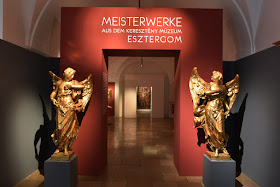The Christian Museum of Esztergom is the largest ecclesiastical collection in Hungary, conserving European and Hungarian works of art from several centuries. Opened for the public in 1875, it became the third most significant picture gallery in Hungary, closely following the Museum of Fine Arts and the Hungarian National Gallery in Budapest, mainly on account of its Hungarian, Italian, Netherlandish, German and Austrian paintings. Besides the late medieval works of art also the baroque and modern collections, the exceptionally rich collection of the decorative arts, and the collection of prints and drawings are significant. The museum was invited by the Diözesanmuseum St. Pölten in Austria to exhibit around 100 pieces of its collections. The aim of the exhibition and its accompanying catalogue was to offer a view for the German-speaking visitors on the quite unknown and thus for many people surprisingly rich and manifold collection of the Christian Museum and at the same time make the history of Esztergom and of its collections more well-known.
Emese Sarkadi Nagy, researcher at the Christian Museum has provided an overview of the exhibition for readers of the Medieval Hungary blog. Her text follows below.
The material was selected in a way to mirror the diversity of the complete collection, thus objects from the Middle Ages to the twentieth century from several territories are present; however, the most valuable pieces were not allowed to travel for reasons of conservation. A small selection of the exhibits represents the Old Hungarian Collection of the Christian Museum. A considerable part of this collection is formed by panel painting and wood-sculpture originating from the (in medieval times) mainly German-speaking mining towns of so-called Lower Hungary (part of present day's western Slovakia). Workshops of these mining towns produced pieces of liturgical furnishing for a number of parish- and abbey churches of the region, among which are also pieces for the Benedictine Abbey of Garamszentbenedek (Hronský Beňadik, Sankt Benedikt). Besides the famous Calvary-altarpiece of Thomas de Coloswar, dated to 1427 and the wooden Lord's coffin dated to the 1480s (neither of which could be transported to the Austrian exhibition), a number of 15th and 16th century altarpieces and fragments of altarpieces were collected/saved by the founder of the Museum, cardinal János Simor at the end of the 19th century and brought to Esztergom. Two panels of a Calvary altarpiece from 1495 stand for the furnishing of the Garamszentbenedek Abbey in the exhibition. A panel depicting three female Saints, belonging once to an altarpiece originating from Sáros County (Comitatus Sarosiensis), mirroring probably Polish influences, stands for the painting of this more eastern region.
The Hungarian material presented in the exhibition makes organic part of the period's Central European art and often reflects Netherlandish influences, just as Austrian and German painting of the same period does. The latter two regions in most cases transmitted to Hungary the innovations of 15th century Netherlandish painters, like compositional solutions, detailed, often real landscape- and town-representations in the backgrounds, adaptation of well-known, fashionable graphical sources. Thus, standing in a logical relation with the Hungarian part of the medieval material, these features can be observed on the St. Pölten exhibition also on some Austrian, German and Netherlandish panels. (The Madonna of the Wheat by the Master of the Hallein Altarpiece, an Adoration of the Magi from Salzburg, two little panels from Wolf Traut's circle - earlier attributed to Hans Schäuffelin, a depiction of St. Agnes from the Northern Netherlands etc.)
The material presented from the collections of the Christian Museum is completed by a small number of (mainly medieval or late medieval) objects from the Cathedral Library and the Treasury. Thus, objects, which belonged already during the Middle Ages to the collections of the Esztergom Archbishopric are presented, illustrating in this way also the history of the bishopric.
The exhibition is accompanied by a catalogue (Meisterwerke aus dem Keresztény Múzeum Esztergom. Diözesanmuseum St. Pölten. Ed. by Wolfgang Huber, St. Pölten 2015, 211 pages), formulated for the everyday visitor, which offers a number of studies not only on the collection of the Christian Museum, but also the history of the town and the cathedral, the historical relations between Hungary and the Passau bishopric written by both the specialists of the Esztergom institutions as also by those from Austria. A number of catalogue entries offer more detailed information on the exhibited objects.
The selection presented in Sankt Pölten, just as the catalogue and its entries or the study dealing with the collection's history, tried to mirror among others also the fact, that the body of the collection of the Christian Museum is formed of the private collections of the above mentioned cardinal János Simor and by Arnold Ipolyi, bishop of Besztercebánya and Nagyvárad, founder of Hungarian art history. Both of them were much interested in not only in early Italian art, which was very fashionable among collectors of those times, but they also collected pieces of art from Hungary, including painting, sculpture, applied arts and popular arts. The fact that a rich material has been gathered in this way also from the region of Northern Hungary, today's Slovakia, reflects on one hand the large horizont of interest, the broad-mindedness of these museum founders, on the other hand is due to the fact that these territories belonged then to the Esztergom diocese.
Meisterwerke aus dem Keresztény Múzeum Esztergom. Konzeption Dr. Wolfgang Huber und Mag. Ildikó Kontsek. Diözesanmuseum St. Pölten. 12.05.2015 - 31.10. 2015.
Pictures of the St. Pölten exhibition courtesy of the Christian Museum, Esztergom.
Pictures of the St. Pölten exhibition courtesy of the Christian Museum, Esztergom.





Congratulations to the Christian Museum for adding early medieval and late medieval objects from the Cathedral Library and the Treasury. Altarpieces and panels are amazing reminders of art tastes and skills, but illuminated manuscripts, gold, silver and bejewelled objects even more so.
ReplyDeleteIn correct words, masterpieces from Slovakia...
ReplyDelete